Pumping Station Desing - Second Edition by Robert L. Sanks, George Tchobahoglous, Garr M. Jones
Подождите немного. Документ загружается.


or by
another
flanking
path.
In
general,
the
barrier
material should have
an STC
rating about
15 dB
greater than
the
noise reduction predicted
by
Equation
22-37. Note that
the
noise reduction given
by
Equa-
tion 22-37 represents
the
change
in
sound level
at the
receiving position with
and
without
the
barrier.
Example
22-6
Reducing
the
Sound Level
at a
Pumping
Station
Problem:
A
pumping station with concrete exterior walls
200 mm (8
in.) thick houses
two
500-kVA
(670-hp),
1800-rev/min
standby diesel generators that supply power
to six
200-kVA
(270-hp),
600-rev/min
direct-drive
centrifugal
pumps,
two of
which
are
backups.
The
layout
of the
pumping
station
is
such that
the
nearest residential property
is 60
m
(197
ft)
from
the
edge
of
the
building,
as
shown
in
Figure 22-26. Compute
the
expected noise levels inside
and
outside
of
the
building
with
no
special acoustical considerations, then determine
the
appropriate measures
needed
to
reduce
the
acoustical impact
to an
acceptable level. Assume that
the NRC for the
untreated interior spaces
is
0.10.
An NRC of
0.05
is not
realistic
for
real-life conditions because
of
absorption
from
miscellaneous
fixtures,
etc.
Solution:
Interior
noise levels
in
pump room
and
office.
The
main noise sources
in the
pump room
are
the six
electric
motors that power
the
pumps. From Table
22-12,
the
expected
noise
level
from
each pump
is 98
dBA
at 1 m
(98.8
dBA
at 3
ft).
The
noise level
in the
reverberant
field
from
each pump
is
evaluated
from
Equation 22-30. Assume
the
room dimensions
to be 13 x 26 x 8 m
(43 x 85 x 26
ft).
The
total
surface
area
is S =
1300
m
2
(14,000
ft
2
).
Use
Equation 22-30
and
Table 22-10.
Sl
Units
U.S. Customary
Units
Vev)
=98-10
Iog
10
[(0.1O)(ISOO)]
+ 17
L
p(rev)
=
98.8
- 10
Iog
10
[(0.1)(14,000)]
+
26.5
=
93.8
dBA
-
94
dBA
=
93.8
dBA
-
94
dBA
The
total noise level
in the
pump room
is
evaluated
by
using
four
noise sources
for m in
Equation
22-33.
(Two
of the six
pumps
are
always off.)
Figure
22-26.
Pumping
station
for
Example 22-6.
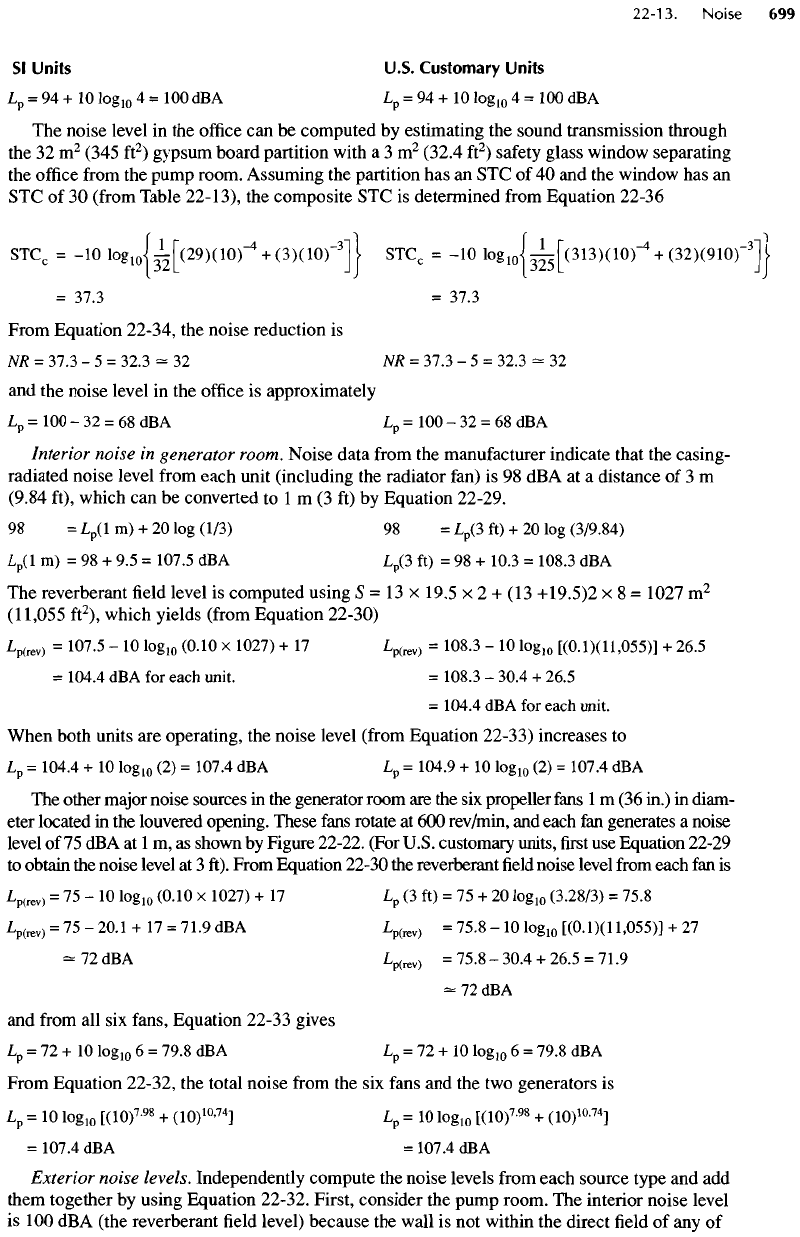
Sl
Units
U.S.
Customary
Units
Lp
= 94 + 10
Iog
10
4
=
100 dBA
L
p
= 94 + 10
Iog
10
4 = 100 dBA
The
noise level
in the
office
can be
computed
by
estimating
the
sound transmission through
the 32 m
2
(345
ft
2
)
gypsum board partition with
a 3
m
2
(32.4
ft
2
)
safety
glass window separating
the
office
from
the
pump room. Assuming
the
partition
has an STC of 40 and the
window
has an
STC of 30
(from
Table
22-13),
the
composite
STC is
determined
from
Equation 22-36
STC
C
= -10
logJlr(29)(10)-
4
+
(3)(10)-
3
lj
STC
C
= -10
logJ-^f(S
13XlO)'
4
+
(32)(910)-
3
11
I
J-^L
Jl
I
OZ
1
D
[_
JJ
=
37.3
=
37.3
From Equation 22-34,
the
noise reduction
is
NR
=
37.3
- 5 =
32.3
-
32
NR
=
37.3
- 5 =
32.3
-
32
and
the
noise level
in the
office
is
approximately
Lp
= 100 - 32 = 68
dBA
L
p
= 100 - 32 = 68 dBA
Interior
noise
in
generator room. Noise data
from
the
manufacturer indicate that
the
casing-
radiated noise level
from
each
unit
(including
the
radiator fan)
is 98 dBA at a
distance
of 3 m
(9.84 ft), which
can be
converted
to 1 m (3 ft) by
Equation 22-29.
98 =
Lp(I
m) + 20 log
(1/3)
98 =
L
p
(3
ft) + 20 log
(3/9.84)
L
p
(l
m) = 98 + 9.5 =
107.5
dBA
L
p
(3
ft) = 98 +
10.3
=
108.3
dBA
The
reverberant
field
level
is
computed using
S = 13 x
19.5
x 2 + (13
+19.5)2
x 8 =
1027
m
2
(11,055
ft
2
),
which yields
(from
Equation 22-30)
L
p(rev)
=
107.5
- 10
Iog
10
(0.10
x
1027)
+ 17
L
p(rev)
=
108.3
- 10
Iog
10
[(O.I)(11,055)]
+
26.5
=
104.4
dBA
for
each
unit.
=
108.3
-
30.4
+
26.5
=
104.4
dBA for
each unit.
When
both units
are
operating,
the
noise level
(from
Equation 22-33) increases
to
Lp
=
104.4
+ 10
Iog
10
(2) =
107.4
dBA
L
p
=
104.9
+ 10
Iog
10
(2) =
107.4
dBA
The
other
major
noise sources
in the
generator room
are the six
propeller
fans
1 m (36
in.)
in
diam-
eter located
in the
louvered opening. These
fans
rotate
at 600
rev/min,
and
each
fan
generates
a
noise
level
of 75 dBA at 1 m, as
shown
by
Figure 22-22. (For U.S. customary units,
first use
Equation 22-29
to
obtain
the
noise level
at 3
ft).
From Equation 22-30
the
reverberant
field
noise level
from
each
fan is
L
P
(rev)
=
75-10
Iog
10
(0.10
x
1027)
+ 17
L
p
(3 ft) = 75 + 20
Iog
10
(3.28/3)
=
75.8
L
p(rev)
= 75 -
20.1
+ 17 =
71.9
dBA
L
p(rev)
=
75.8
- 10
Iog
10
[(0.I)(11,055)]
+ 27
-
72
dBA
L
p(rev)
=
75.8
-
30.4
+
26.5
=
71.9
=*
72 dBA
and
from
all six
fans,
Equation 22-33 gives
Lp
= 72 + 10
Iog
10
6 =
79.8
dBA
L
p
= 72 + 10
Iog
10
6 =
79.8
dBA
From
Equation 22-32,
the
total noise
from
the six
fans
and the two
generators
is
Lp
= 10
lo
glo
[(1O)
7
-
98
+
(1O)
10
'
74
]
Lp = 10
lo
glo
[(1O)
7
-
98
+
(1O)
10
-
74
]
=
107.4
dBA =
107.4
dBA
Exterior
noise levels. Independently compute
the
noise levels
from
each source type
and add
them
together
by
using Equation 22-32. First, consider
the
pump room.
The
interior noise level
is
100
dBA
(the
reverberant
field
level) because
the
wall
is not
within
the
direct
field of any of
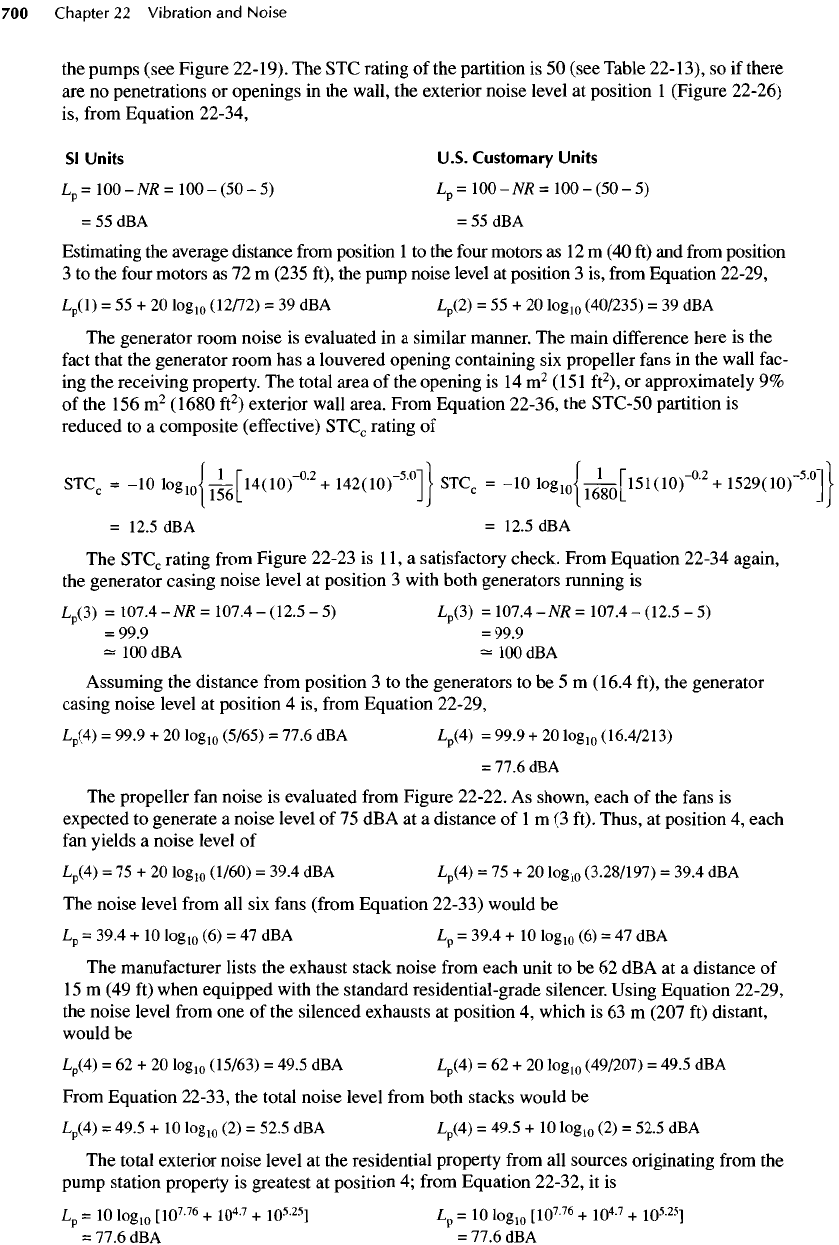
the
pumps (see
Figure
22-19).
The STC
rating
of the
partition
is 50
(see Table
22-13),
so if
there
are
no
penetrations
or
openings
in the
wall,
the
exterior noise level
at
position
1
(Figure 22-26)
is,
from
Equation 22-34,
Sl
Units
U.S. Customary Units
Lp
=
100
-NR =
100
-
(50
- 5)
L
p
=
100
-NR =
100
-
(50
- 5)
=
55 dBA
=
55 dBA
Estimating
the
average distance
from
position
1 to the
four
motors
as 12 m (40 ft) and
from
position
3 to the
four
motors
as 72 m
(235 ft),
the
pump noise level
at
position
3 is,
from
Equation 22-29,
L
p
(l)
= 55 + 20
Iog
10
(12/72)
= 39 dBA
L
p
(2)
= 55 + 20
Iog
10
(40/235)
= 39 dBA
The
generator room noise
is
evaluated
in a
similar manner.
The
main
difference
here
is the
fact
that
the
generator room
has a
louvered opening containing
six
propeller
fans
in the
wall fac-
ing the
receiving property.
The
total area
of the
opening
is 14
m
2
(151
ft
2
),
or
approximately
9%
of
the
156
m
2
(1680
ft
2
)
exterior wall area. From Equation 22-36,
the
STC-50 partition
is
reduced
to a
composite
(effective)
STC
C
rating
of
STC
C
=
-10
1Og
10
J
1
^[M(IO)-
0
-
2
+
142(10)-
5
-°]I
STC
C
= -10
logJ^lSKlO)^
2
+
1529(1O)-
5
'
0
]J
=
12.5
dBA =
12.5
dBA
The
STC
C
rating
from
Figure 22-23
is
11,
a
satisfactory check. From Equation 22-34 again,
the
generator casing noise level
at
position
3
with both generators running
is
L
p
(3)
=107.4-NR
=107.4-(12.5
-5)
L
p
(3)
=
107.4-NR
=
101
A-
(12.5
-5)
=
99.9
=
99.9
=*
100 dBA
=*
100 dBA
Assuming
the
distance
from
position
3 to the
generators
to be 5 m
(16.4 ft),
the
generator
casing noise level
at
position
4 is,
from
Equation
22-29,
L
p
(4)
=
99.9
+ 20
Iog
10
(5/65)
=
77.6
dBA
L
p
(4)
=
99.9
+ 20
Iog
10
(16.4/213)
=
77.6
dBA
The
propeller
fan
noise
is
evaluated
from
Figure 22-22.
As
shown, each
of the
fans
is
expected
to
generate
a
noise level
of 75 dBA at a
distance
of 1 m (3
ft). Thus,
at
position
4,
each
fan
yields
a
noise level
of
L
p
(4)
= 75 + 20
Iog
10
(1/60)
=
39.4
dBA
L
p
(4)
= 75 + 20
Iog
10
(3.28/197)
=
39.4
dBA
The
noise level
from
all six
fans
(from
Equation 22-33) would
be
Lp
=
39.4
+ 10
Iog
10
(6) = 47 dBA
L
p
=
39.4
+ 10
Iog
10
(6) = 47 dBA
The
manufacturer
lists
the
exhaust stack noise
from
each unit
to be 62 dBA at a
distance
of
15m
(49 ft)
when equipped with
the
standard residential-grade silencer. Using Equation 22-29,
the
noise level
from
one of the
silenced exhausts
at
position
4,
which
is 63 m
(207
ft)
distant,
would
be
L
p
(4)
= 62 + 20
Iog
10
(15/63)
=
49.5
dBA
L
p
(4)
= 62 + 20
Iog
10
(49/207)
=
49.5
dBA
From Equation 22-33,
the
total noise level
from
both stacks would
be
L
p
(4)
=
49.5
+ 10
Iog
10
(2) =
52.5
dBA
L
p
(4)
=
49.5
+ 10
Iog
10
(2) =
52.5
dBA
The
total exterior noise level
at the
residential property
from
all
sources originating
from
the
pump
station property
is
greatest
at
position
4;
from
Equation 22-32,
it is
Lp
=
10
Iog
10
[10
7
-
76
+
10
4
-
7
+
10
5
-
25
]
Lp = 10
Iog
10
[10
7
-
76
+
10
4
-
7
+
10
5
-
25
]
=
77.6
dBA
=
77.6
dBA
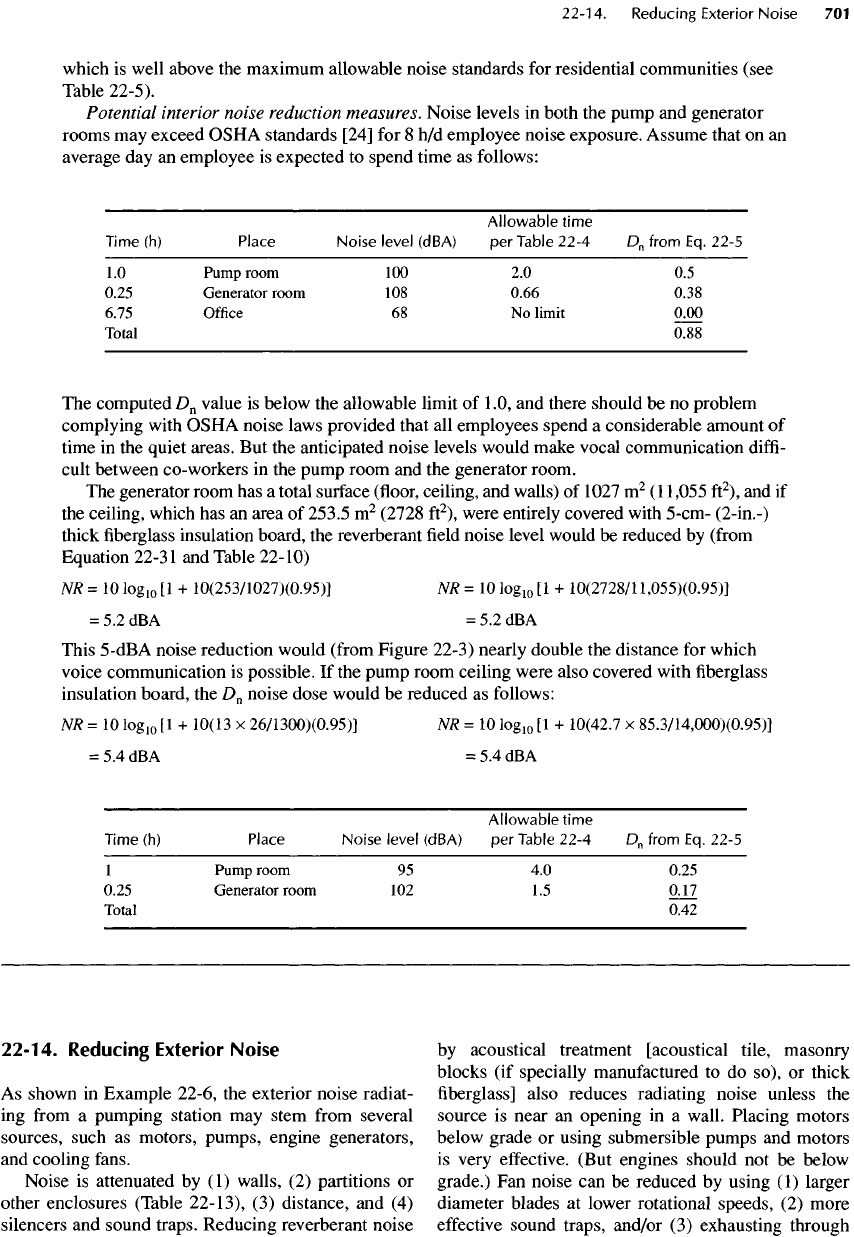
22-14.
Reducing
Exterior
Noise
As
shown
in
Example
22-6,
the
exterior noise radiat-
ing
from
a
pumping station
may
stem
from
several
sources, such
as
motors, pumps, engine generators,
and
cooling
fans.
Noise
is
attenuated
by (1)
walls,
(2)
partitions
or
other
enclosures (Table 22-13),
(3)
distance,
and (4)
silencers
and
sound traps. Reducing reverberant noise
by
acoustical treatment [acoustical tile, masonry
blocks
(if
specially manufactured
to do
so),
or
thick
fiberglass]
also reduces radiating noise unless
the
source
is
near
an
opening
in a
wall. Placing motors
below grade
or
using submersible pumps
and
motors
is
very
effective.
(But
engines should
not be
below
grade.)
Fan
noise
can be
reduced
by
using
(1)
larger
diameter blades
at
lower rotational speeds,
(2)
more
effective
sound traps, and/or
(3)
exhausting through
which
is
well above
the
maximum allowable noise standards
for
residential communities
(see
Table
22-5).
Potential interior noise reduction measures. Noise levels
in
both
the
pump
and
generator
rooms
may
exceed OSHA standards
[24]
for 8 h/d
employee noise exposure. Assume that
on an
average
day an
employee
is
expected
to
spend time
as
follows:
Allowable time
Time
(h)
Place
Noise level
(dBA)
per
Table
22-4
D
n
from
Eq.
22-5
1.0
Pump
room
100 2.0 0.5
0.25 Generator room
108
0.66 0.38
6.75
Office
68 No
limit
0.00
Total
0.88
The
computed
D
n
value
is
below
the
allowable limit
of
1.0,
and
there should
be no
problem
complying
with OSHA noise laws provided that
all
employees spend
a
considerable amount
of
time
in the
quiet areas.
But the
anticipated noise levels would make vocal communication
diffi-
cult
between co-workers
in the
pump room
and the
generator room.
The
generator room
has a
total surface
(floor,
ceiling,
and
walls)
of
1027
m
2
(11,055
ft
2
),
and if
the
ceiling, which
has an
area
of
253.5
m
2
(2728
ft
2
),
were entirely covered with
5-cm-
(2-in.-)
thick fiberglass insulation board,
the
reverberant
field
noise level would
be
reduced
by
(from
Equation
22-31
and
Table 22-10)
NR
= 10
Iog
10
[1 +
10(253/1027)(0.95)]
NR = 10
Iog
10
[1 +
10(2728/11,055)(0.95)]
=
5.2 dBA = 5.2 dBA
This
5-dBA
noise reduction would
(from
Figure
22-3)
nearly double
the
distance
for
which
voice communication
is
possible.
If the
pump room
ceiling
were also covered with
fiberglass
insulation
board,
the
D
n
noise dose would
be
reduced
as
follows:
NR
= 10
Iog
10
[1 +
10(13
x
26/1300)(0.95)]
NR = 10
Iog
10
[1 +
10(42.7
x
85.3/14,000)(0.95)]
=
5.4 dBA
=
5.4 dBA
Allowable
time
Time
(h)
Place
Noise level (dBA)
per
Table
22-4
D
n
from
Eq.
22-5
1
Pump
room
95 4.0
0.25
0.25
Generator
room
102 1.5
0.17
Total
0.42
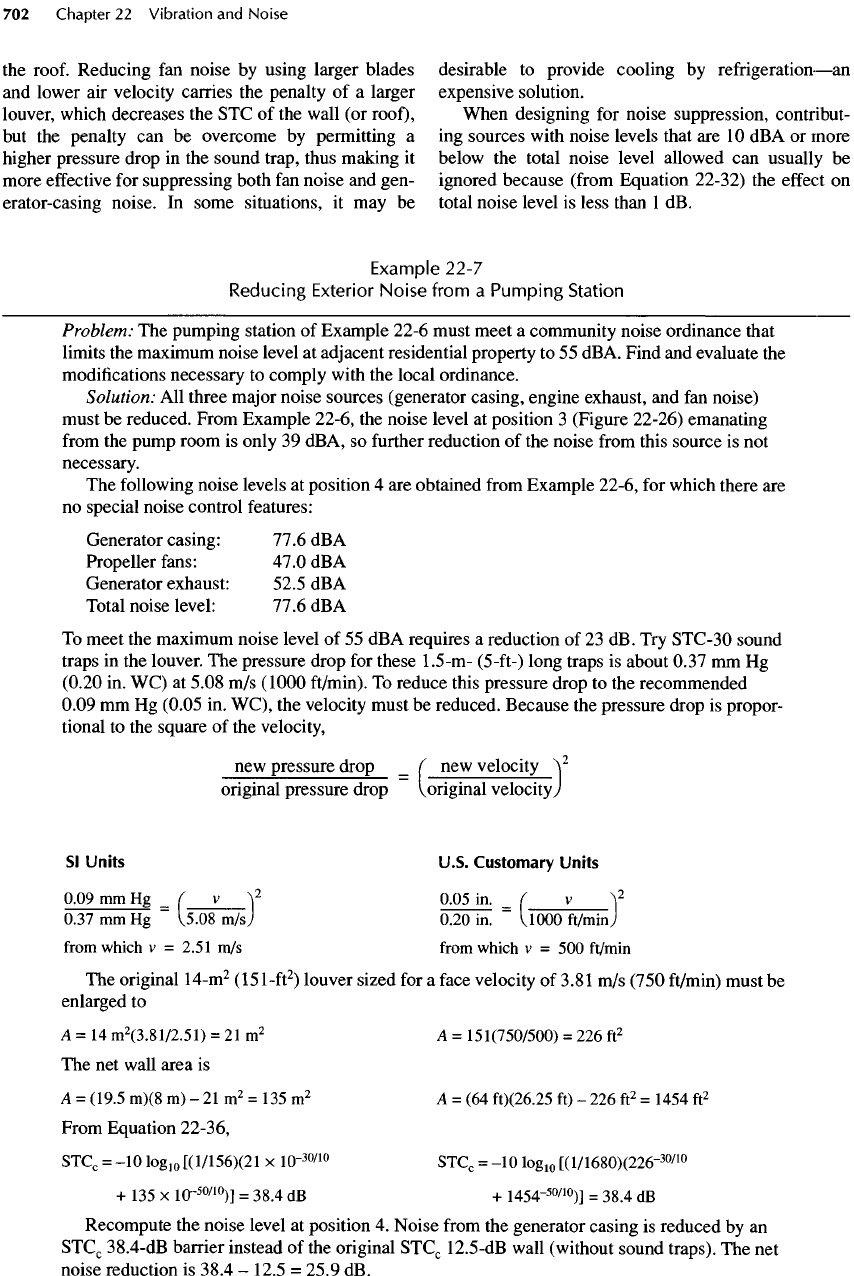
the
roof. Reducing
fan
noise
by
using larger blades
and
lower
air
velocity carries
the
penalty
of a
larger
louver,
which decreases
the STC of the
wall
(or
roof),
but
the
penalty
can be
overcome
by
permitting
a
higher
pressure drop
in the
sound trap, thus making
it
more
effective
for
suppressing both
fan
noise
and
gen-
erator-casing noise.
In
some situations,
it may be
desirable
to
provide cooling
by
refrigeration
—
an
expensive solution.
When
designing
for
noise suppression, contribut-
ing
sources with noise levels that
are 10
dBA
or
more
below
the
total noise level allowed
can
usually
be
ignored because
(from
Equation 22-32)
the
effect
on
total noise level
is
less than
1 dB.
Example 22-7
Reducing
Exterior
Noise
from
a
Pumping
Station
Problem:
The
pumping station
of
Example 22-6 must meet
a
community noise ordinance that
limits
the
maximum noise level
at
adjacent residential property
to 55
dBA. Find
and
evaluate
the
modifications
necessary
to
comply with
the
local ordinance.
Solution:
All
three
major
noise sources (generator casing, engine exhaust,
and fan
noise)
must
be
reduced. From Example 22-6,
the
noise level
at
position
3
(Figure 22-26) emanating
from
the
pump room
is
only
39
dBA,
so
further
reduction
of the
noise
from
this source
is not
necessary.
The
following
noise levels
at
position
4 are
obtained
from
Example 22-6,
for
which there
are
no
special noise control features:
Generator casing: 77.6
dBA
Propeller
fans:
47.0
dBA
Generator exhaust: 52.5
dBA
Total
noise level: 77.6
dBA
To
meet
the
maximum noise level
of 55 dBA
requires
a
reduction
of 23 dB. Try
STC-30
sound
traps
in the
louver.
The
pressure drop
for
these
1.5-m-
(5-ft-)
long traps
is
about 0.37
mm Hg
(0.20
in. WC) at
5.08
m/s
(1000
ft/min).
To
reduce this pressure drop
to the
recommended
0.09
mm Hg
(0.05
in.
WC),
the
velocity must
be
reduced.
Because
the
pressure
drop
is
propor-
tional
to the
square
of the
velocity,
new
pressure drop
_
(
new
velocity
\
2
original pressure drop
v
original
velocity
y
Sl
Units
U.S.
Customary
Units
0.09
mm
Hg
=
(
v
}
2
0.05
in.
=
(
v
\
2
0.37
mm Hg ~
b.08
m/s
J
0.20
in. ~
UOOO
ft/minJ
from
which
v =
2.51
m/s
from
which
v = 500
ft/min
The
original
14-m
2
(151-ft
2
)
louver sized
for a
face
velocity
of
3.81
m/s
(750
ft/min)
must
be
enlarged
to
A
= 14
m
2
(3.81/2.51)
= 21 m
2
A=
151(750/500)
= 226
ft
2
The net
wall
area
is
A
=
(19.5 m)(8
m)
-21m
2
=
135
m
2
A = (64 ft)(26.25 ft) - 226
ft
2
=
1454
ft
2
From
Equation
22-36,
STC
C
=
-10
Iog
10
[(1/156X21
x
10-
30/1
°
STC
C
= -10
Iog
10
[(1/1680)(226-
30/1
°
+
135 x
10-
50/10
)]
=
38.4
dB +
1454-
50
/
10
)]
=
38.4
dB
Recompute
the
noise level
at
position
4.
Noise
from
the
generator casing
is
reduced
by an
STC
C
38.4-dB barrier instead
of the
original
STC
C
12.5-dB
wall (without sound traps).
The net
noise reduction
is
38.4
-
12.5
=
25.9
dB.

An
additional
margin
of
safety
is
possible,
but it
may
become
quite
expensive.
Generally
speaking,
noise
control
measures
tend
to
follow
the law of
diminishing returns; that
is, the
cost
of the first 10
dBA
of
noise
reduction
is
generally
much
less
expen-
sive than
the
second
10
dBA,
and so on. In
situations
where
noise
is
important,
it is
usually
cost
effective
to
hire
a
consultant
who can
take
the
responsibility
of
performing
a
detailed
frequency
analysis
and
specify-
ing
exactly what
is
required
to
meet
code
require-
ments without
excessive
safety
margins.
22-15.
References
1.
Karassik,
I.
J.,
W. C.
Krutzsch,
W. H.
Eraser,
and J. P.
Messina. Pump Handbook,
2nd ed.
McGraw-Hill,
New
York
(1986).
2.
American National Standard
for
Reciprocating Pumps
for
Nomenclature,
Definitions,
Application
and
Operation,
ANSI/HI
6.1-6.5-1994.
Hydraulic Institute,
Parsippany,
NJ
(1994).
3.
American National Standard
for
Centrifugal Pumps
for
Nomenclature, Definitions, Application
and
Operation,
ANSI/HI
1.1-1.5-1994.
Hydraulic Institute, Parsippany,
NJ
(1994).
4.
American National Standard
for
Vertical Pumps
for
Nomenclature,
Definitions,
Application
and
Operation,
ANSI/HI
2.1-2.5-1994.
Hydraulic Institute, Parsippany,
NJ
(1994).
5.
Reichaert,
F.
E.,
J. R.
Hall,
and R. D.
Woods.
Vibrations
of
Soils
and
Foundations. Prentice-Hall,
Englewood
Cliffs,
NJ
(1970).
6.
Marscher,
W. D.
"Determination
of
pump rotor critical
speeds during operation through
use of
modal analysis."
Proceedings ASME 1986
WAM
Symposium
on
Troubleshooting Methods
and
Technology, Anaheim,
CA
(December 1986).
7.
Blevins,
R. D.
Formulas
for
Natural
Frequency
and
Mode
Shape.
Robert Krieger Publishing Co., Malabar,
FL
(1984).
8.
Marscher,
W. D.
"The
effect
of
variable
frequency
drives
on
vibration problems
in
vertical pumps."
Proceedings
of the
Water
&
Wastewater 1990
Conference
(Publ.
Walpole Productions, Houston),
Barcelona, Spain (April
24,
1990).
9.
Rathbone,
T.
"Vibration tolerance." Power Plant
Engineering,
43:721-724
(November 1939).
10.
Blake,
M.
"New vibration standards
for
maintenance."
Hydrocarbon
Processing
and
Petroleum
Refining,
43:
11
1-1
14
(January 1964).
11.
Baxter.
R. L. and D. L.
Bernard. "Vibration tolerances
for
industry." American Society
of
Mechanical
Engineers,
67-PET-14:l-8
(1967).
12.
Hancock,
W. P.
"How
to
control pump vibration."
Hydrocarbon
Processing,
53:107-113
(March 1974).
13.
Marscher,
W. D.
"The relationship between pump rotor
system
tribology
and
appropriate vibration specifications
The
propeller
fan
noise
is
reduced
by the STC
rating
of the
sound traps
(30 dB)
minus
the
STC
rating
of the
louver
(2 dB) for a net
noise
reduction
of 28 dB. The
components
at
position
4
are, therefore,
Generator
casing
(77.6
-
25.9)
=51.7
dBA
Propeller
fans
(47 - 28)
=19
dBA
Generator
exhaust
=52.5
dBA
and
the
total
noise
from
Equation
22-32
is
Lp
=
10
Iog
10
[10
5L7/1
°
+
10
19/1
°
Lp
=
10
Iog
10
[10
5L7/1
°
+
10
19/1
°
+
10
52
-
5/1
°]
=
55.1
dBA +
10
52
-
5/1
°]
=
55.1
dBA
This
sound
level
is
just slightly
above
the
55-dBA
limit.
To
make further
reductions,
choose
critical-grade
exhaust
silencers
for an
additional
5-dB
noise
reduction
on the
exhaust
noise.
Note
that both
engines
must
be
silenced
with
critical-grade
silencers
to
achieve this
result.
With
the
critical-grade
exhaust
silencers
and the STC 30
sound traps,
the
noise
level
at
posi-
tion
4 is
Generator
casing:
51.7
dBA
Propeller
fans: 19.0
dBA
Generator
exhaust: 47.5
dBA
Total
noise
level:
53.1
dBA
(from
Equation
22-32)
This
meets
the
noise
ordinance
with
a
small
margin
of
safety.
For an
increased
margin
of
safety,
STC-35
sound traps could
be
used
for the
louver opening.
This
application would
require
sound
traps that
are
2.1
m (7 ft)
long,
which would
require
considerable
floor
space—one
of the
sev-
eral
reasons
for
avoiding retrofit
in
favor
of
planning
for
noise
reduction
during
the first
stages
of
layout.
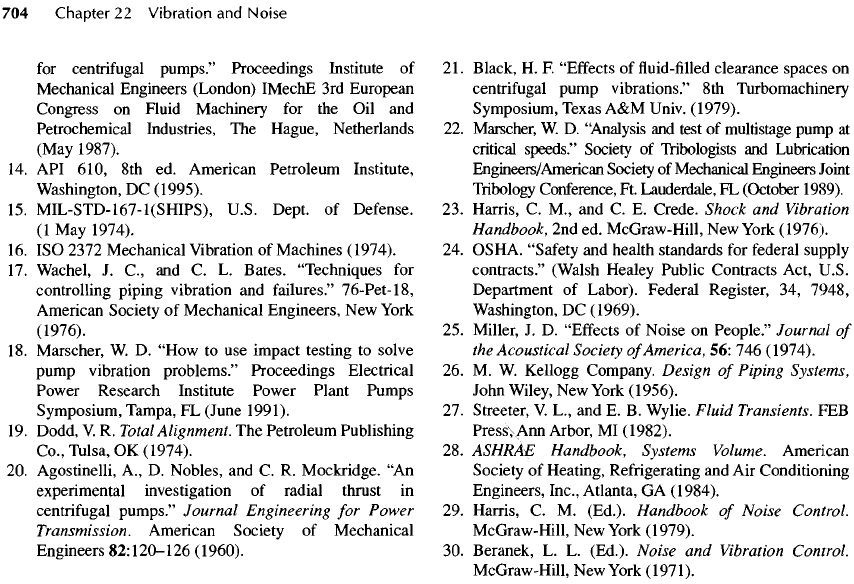
for
centrifugal pumps." Proceedings Institute
of
Mechanical Engineers (London)
IMechE
3rd
European
Congress
on
Fluid Machinery
for the Oil and
Petrochemical Industries,
The
Hague, Netherlands
(May
1987).
14.
API
610,
8th ed.
American Petroleum Institute,
Washington,
DC
(1995).
15.
MIL-STD-
167-1
(SHIPS), U.S. Dept.
of
Defense.
(1
May
1974).
16. ISO
2372 Mechanical Vibration
of
Machines (1974).
17.
Wachel,
J.
C.,
and C. L.
Bates. "Techniques
for
controlling piping vibration
and
failures."
76-Pet-18,
American Society
of
Mechanical Engineers,
New
York
(1976).
18.
Marscher,
W. D.
"How
to use
impact testing
to
solve
pump
vibration problems." Proceedings Electrical
Power
Research Institute Power Plant Pumps
Symposium,
Tampa,
FL
(June
1991).
19.
Dodd,
V. R.
Total
Alignment.
The
Petroleum Publishing
Co.,
Tulsa,
OK
(1974).
20.
Agostinelli,
A.,
D.
Nobles,
and C. R.
Mockridge.
"An
experimental
investigation
of
radial thrust
in
centrifugal
pumps." Journal Engineering
for
Power
Transmission.
American Society
of
Mechanical
Engineers
82:120-126
(1960).
21.
Black,
H. F.
"Effects
of fluid-filled
clearance spaces
on
centrifugal
pump vibrations."
8th
Turbomachinery
Symposium,
Texas
A&M
Univ. (1979).
22.
Marscher,
W. D.
"Analysis
and
test
of
multistage pump
at
critical
speeds."
Society
of
Tribologists
and
Lubrication
Engineers/American Society
of
Mechanical Engineers Joint
Tribology
Conference,
Ft.
Lauderdale,
FL
(October 1989).
23.
Harris,
C.
M.,
and C. E.
Crede. Shock
and
Vibration
Handbook,
2nd ed.
McGraw-Hill,
New
York (1976).
24.
OSHA. "Safety
and
health standards
for
federal supply
contracts."
(Walsh Healey Public Contracts Act, U.S.
Department
of
Labor).
Federal
Register,
34,
7948,
Washington,
DC
(1969).
25.
Miller,
J. D.
"Effects
of
Noise
on
People."
Journal
of
the
Acoustical Society
of
America,
56: 746
(1974).
26. M. W.
Kellogg Company. Design
of
Piping Systems,
John Wiley,
New
York (1956).
27.
Streeter,
V.
L.,
and E. B.
Wylie.
Fluid Transients.
FEB
Press>
Ann
Arbor,
MI
(1982).
28.
ASHRAp
Handbook, Systems
Volume.
American
Society
of
Heating, Refrigerating
and Air
Conditioning
Engineers, Inc., Atlanta,
GA
(1984).
29.
Harris,
C. M.
(Ed.).
Handbook
of
Noise Control.
McGraw-Hill,
New
York
(1979).
30.
Beranek,
L. L.
(Ed.).
Noise
and
Vibration Control.
McGraw-Hill,
New
York (1971).
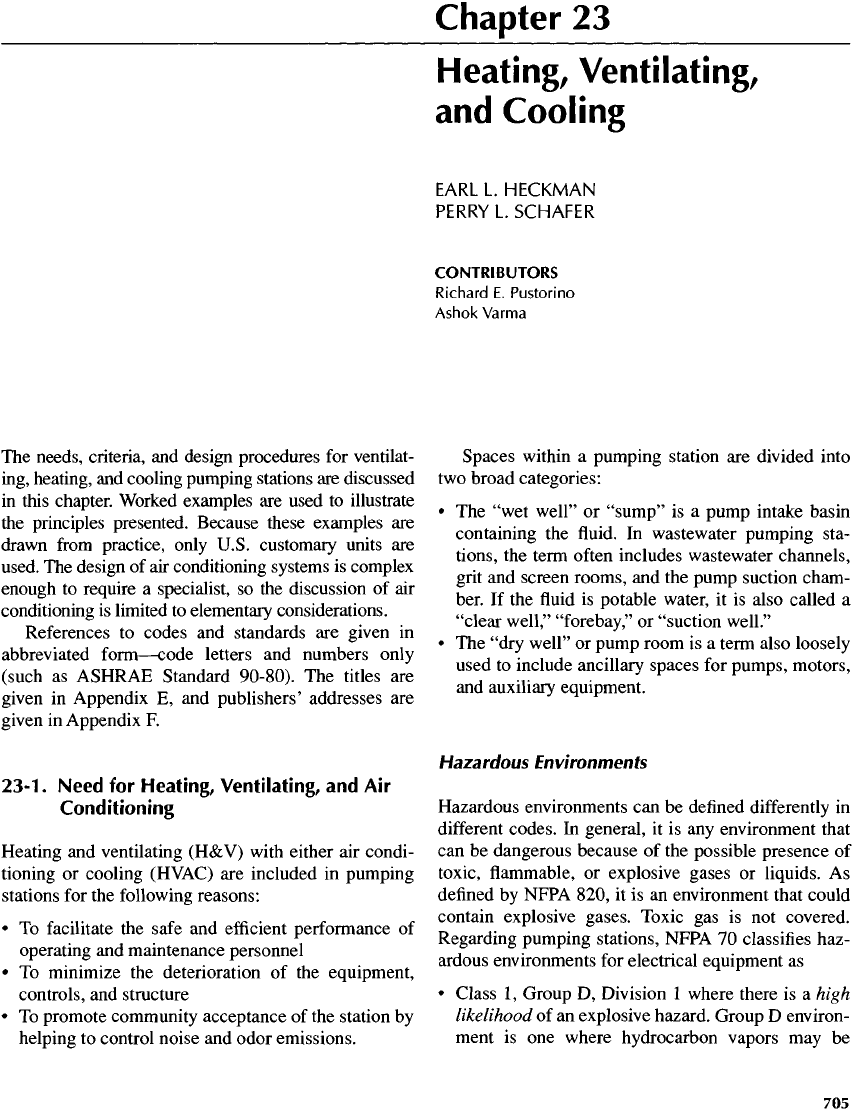
The
needs, criteria,
and
design procedures
for
ventilat-
ing,
heating,
and
cooling pumping stations
are
discussed
in
this chapter. Worked examples
are
used
to
illustrate
the
principles presented. Because these examples
are
drawn
from
practice, only U.S. customary units
are
used.
The
design
of air
conditioning systems
is
complex
enough
to
require
a
specialist,
so the
discussion
of air
conditioning
is
limited
to
elementary considerations.
References
to
codes
and
standards
are
given
in
abbreviated
form
—
code
letters
and
numbers only
(such
as
ASHRAE Standard
90-80).
The
titles
are
given
in
Appendix
E, and
publishers' addresses
are
given
in
Appendix
F.
23-1.
Need
for
Heating,
Ventilating,
and Air
Conditioning
Heating
and
ventilating (H&V) with either
air
condi-
tioning
or
cooling
(HVAC)
are
included
in
pumping
stations
for the
following reasons:
• To
facilitate
the
safe
and
efficient
performance
of
operating
and
maintenance personnel
• To
minimize
the
deterioration
of the
equipment,
controls,
and
structure
• To
promote community acceptance
of the
station
by
helping
to
control noise
and
odor emissions.
Chapter
23
Heating,
Ventilating,
and
Cooling
EARL
L.
HECKMAN
PERRY
L.
SCHAFER
CONTRIBUTORS
Richard
E.
Pustorino
Ashok
Varma
Spaces within
a
pumping station
are
divided into
two
broad
categories:
• The
"wet
well"
or
"sump"
is a
pump intake basin
containing
the fluid. In
wastewater pumping sta-
tions,
the
term
often
includes wastewater channels,
grit
and
screen rooms,
and the
pump suction cham-
ber.
If the fluid is
potable water,
it is
also called
a
"clear
well,"
"forebay,"
or
"suction
well."
• The
"dry
well"
or
pump room
is a
term also loosely
used
to
include ancillary spaces
for
pumps, motors,
and
auxiliary equipment.
Hazardous
Environments
Hazardous environments
can be
defined
differently
in
different
codes.
In
general,
it is any
environment that
can
be
dangerous because
of the
possible presence
of
toxic,
flammable, or
explosive gases
or
liquids.
As
defined
by
NFPA 820,
it is an
environment that could
contain explosive gases. Toxic
gas is not
covered.
Regarding pumping stations, NFPA
70
classifies
haz-
ardous environments
for
electrical
equipment
as
•
Class
1,
Group
D,
Division
1
where
there
is a
high
likelihood
of an
explosive hazard. Group
D
environ-
ment
is one
where hydrocarbon vapors
may be

present.
There
are
about
a
dozen hazardous environ-
ment
groups.
All
equipment
in
Group
D
must
be
explosionproof
—
an
expensive requirement
for
polyphase motors.
•
Class
1,
Group
D,
Division
2
where there
is
the
pos-
sibility
of an
explosive hazard. Only single-phase
equipment
(switches, lights, motors) must
be
explo-
sionproof.
A
Division
1
classification
is
assigned
to a wet
well
either
not
ventilated
or
only intermittently ventilated
in
accordance with NFPA
820
criteria.
If the
pump
intake basin
is
well ventilated
at all
times,
the
likeli-
hood
of an
explosive atmosphere
is
greatly reduced
and
the
space could
be
reclassified
as
Division
2.
Personnel
Safety
There have been
too
many incidents
of
death
and
injury
to
ignore good practice
for
workers entering
any
room containing wastewater
or the
possibility that
sewer
gases could enter
a
room. Some jurisdictions
require permanently installed meters
for
explosive
gas
(hydrocarbons),
hydrogen
sulfide,
and low
oxygen
levels. However,
the
chance that such equipment will
not
be
calibrated with adequate frequency
or
that
detectors will become fouled with hydrogen
sulfide
poses
a
risk.
It is
better that workers
be
equipped with
portable monitors regularly calibrated
and
tested.
The
monitors
are
expensive,
but
there
is no
good substitute
for
the
protection they
offer.
Confined
Spaces
OSHA
defines
confined
spaces
as
follows:
• A
"confined
space"
is an
area that
is
large enough
and
so
configured
that
an
employee
can
bodily enter
and
perform assigned work,
has
limited
or
restricted
means
for
entry
or
exit [for example: tanks, vessels,
silos, storage bins, hoppers, vaults, trenches greater
than
1.2 m (4 ft) in
depth,
and
pits]
and is not
designed
for
continuous occupancy.
• A
"permit
required confined
space"
is
defined
as a
confined
space with
one or
more
of the
following
characteristics: Contains
or has the
potential
to
con-
tain
a
hazardous atmosphere such
as
lack
of
oxygen
(less than 19.5%),
or
explosive
or
toxic gasses; con-
tains
a
material that
has the
potential
for
engulfing
an
entrant;
has an
internal configuration such that
an
entrant
could
be
trapped
or
asphyxiated
by
inwardly
converging walls
or a floor
that slopes
downward
and
tapers
to a
smaller
section;
or
con-
tains
any
other
recognized
serious
safety
or
health
hazard.
Merely providing ventilation
per
codes, such
as
NFPA
820 or the
Ten-States Standards, does
not by
itself
change
the
classification
of a
confined
space
to a
non-
confined
space.
The
criteria regarding entry, exit,
and
continuous
occupancy must also
be
addressed.
In
practical terms,
it
would seem that
the
following fea-
tures must
be
present
in a
wastewater pumping station
wet
well
to
avoid classification
as a
confined
space:
•
Stairway
access.
Ladder
access
probably would
not
be
considered
to
meet
the
criteria
of
eliminating
"limited
or
restricted means
for
entry
or
exit."
•
Permanently installed, continuous ventilation
suffi-
cient
to
control
the
accumulation
of any
hazardous
(toxic
or
explosive) gasses
and
prevent oxygen deple-
tion below concentrations necessary
to
support
life.
•
Permanently installed lighting.
•
Permanently installed
or (if
always used) portable
detectors
for
combustible gas, hydrogen
sulfide,
and
oxygen concentrations.
Even with
the
above features, there
are
some sanita-
tion agencies that
do not
allow individuals
to
enter
wet
wells alone. They must always
be
accompanied
by an
observer
who
does
not go
with them
into
the wet
well.
Hazards
in Wet
Wells
Proper
ventilation
of
pumping stations
is an
often
mis-
understood
and
neglected subject. Enclosures below
grade, such
as wet
wells
and
vaults,
are
considered
by
OSHA
to be
confined
spaces,
and
there
are
stringent
requirements
for
access
to
them
and
elaborate protec-
tive measures
for
persons entering them. Many deaths
in
both water
and
wastewater pumping stations could
have
been avoided with good ventilation. Although
ventilation
by
itself does
not
change
the
classification
of
a
"confined
space"
to an
"unconfined
space,"
good
ventilation goes
a
long
way in
improving
the
safety
of
wastewater
pumping stations.
In an
accident
in
England, methane
gas
leaked
from
the
forebay into
a
water pumping station
and
collected
over
a
weekend.
The
station
was not
continuously ventilated. When
a
party
of
visitors entered
the
station,
a
spark
from
the
lighting system caused
an
explosion
that killed
14
people.
In
another incident,
an
operator
on his
normal
rounds breathed
a
fatal
concentration
of
hydrogen sul-
fide gas in a wet
well inadequately ventilated
by an
inappropriate
design.
In
subsequent
air
sampling,
hydrogen
sulfide
concentrations
up to 20
times greater
than
the
recommended limit were
found.
These
exam-
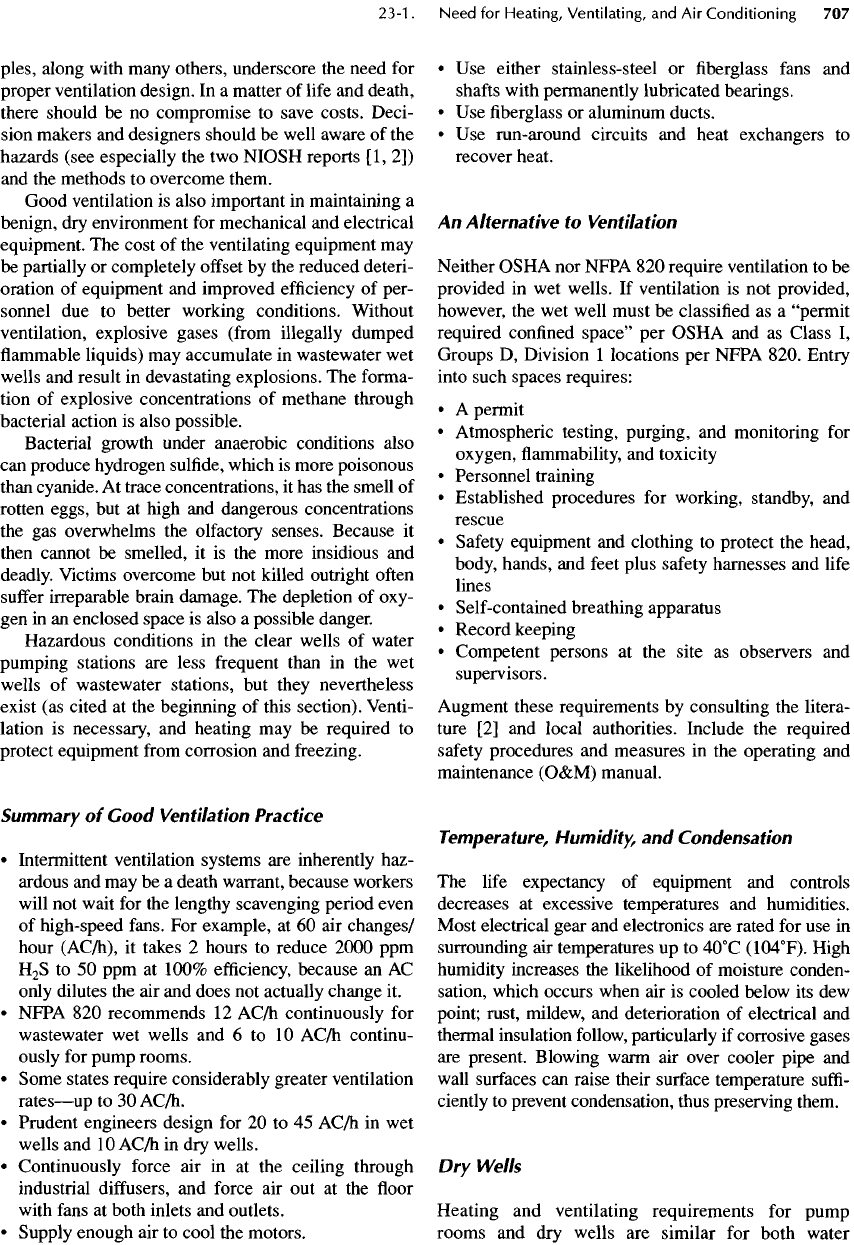
pies,
along
with
many others, underscore
the
need
for
proper ventilation design.
In a
matter
of
life
and
death,
there should
be no
compromise
to
save costs. Deci-
sion makers
and
designers should
be
well aware
of the
hazards
(see especially
the two
NIOSH reports
[1,2])
and
the
methods
to
overcome them.
Good ventilation
is
also important
in
maintaining
a
benign,
dry
environment
for
mechanical
and
electrical
equipment.
The
cost
of the
ventilating equipment
may
be
partially
or
completely
offset
by the
reduced deteri-
oration
of
equipment
and
improved
efficiency
of
per-
sonnel
due to
better working conditions. Without
ventilation,
explosive gases
(from
illegally dumped
flammable
liquids)
may
accumulate
in
wastewater
wet
wells
and
result
in
devastating explosions.
The
forma-
tion
of
explosive concentrations
of
methane through
bacterial action
is
also possible.
Bacterial
growth under anaerobic conditions also
can
produce hydrogen
sulfide,
which
is
more poisonous
than
cyanide.
At
trace concentrations,
it has the
smell
of
rotten eggs,
but at
high
and
dangerous concentrations
the
gas
overwhelms
the
olfactory senses. Because
it
then
cannot
be
smelled,
it is the
more insidious
and
deadly.
Victims overcome
but not
killed outright
often
suffer
irreparable brain damage.
The
depletion
of
oxy-
gen
in an
enclosed space
is
also
a
possible danger.
Hazardous conditions
in the
clear wells
of
water
pumping
stations
are
less
frequent
than
in the wet
wells
of
wastewater stations,
but
they nevertheless
exist
(as
cited
at the
beginning
of
this
section).
Venti-
lation
is
necessary,
and
heating
may be
required
to
protect equipment
from
corrosion
and
freezing.
Summary
of
Good
Ventilation
Practice
•
Intermittent ventilation systems
are
inherently haz-
ardous
and may be a
death warrant, because workers
will
not
wait
for the
lengthy scavenging period even
of
high-speed
fans.
For
example,
at 60 air
changes/
hour
(AC/h),
it
takes
2
hours
to
reduce
2000
ppm
H
2
S
to 50 ppm at
100%
efficiency,
because
an AC
only
dilutes
the air and
does
not
actually change
it.
•
NFPA
820
recommends
12
AC/h
continuously
for
wastewater
wet
wells
and 6 to 10
AC/h
continu-
ously
for
pump rooms.
•
Some states require considerably greater ventilation
rates
—
up
to 30
AC/h.
•
Prudent engineers design
for 20 to 45
AC/h
in wet
wells
and 10
AC/h
in dry
wells.
•
Continuously force
air in at the
ceiling through
industrial
diffusers,
and
force
air out at the floor
with
fans
at
both inlets
and
outlets.
•
Supply enough
air to
cool
the
motors.
• Use
either stainless-steel
or fiberglass
fans
and
shafts
with permanently lubricated bearings.
• Use fiberglass or
aluminum ducts.
• Use
run-around circuits
and
heat exchangers
to
recover heat.
An
Alternative
to
Ventilation
Neither OSHA
nor
NFPA
820
require ventilation
to be
provided
in wet
wells.
If
ventilation
is not
provided,
however,
the wet
well must
be
classified
as a
"permit
required confined
space"
per
OSHA
and as
Class
I,
Groups
D,
Division
1
locations
per
NFPA 820. Entry
into such spaces requires:
• A
permit
•
Atmospheric testing, purging,
and
monitoring
for
oxygen,
flammability, and
toxicity
•
Personnel training
•
Established procedures
for
working, standby,
and
rescue
•
Safety
equipment
and
clothing
to
protect
the
head,
body,
hands,
and
feet
plus
safety
harnesses
and
life
lines
•
Self-contained breathing apparatus
•
Record keeping
•
Competent persons
at the
site
as
observers
and
supervisors.
Augment
these
requirements
by
consulting
the
litera-
ture
[2] and
local authorities. Include
the
required
safety
procedures
and
measures
in the
operating
and
maintenance (O&M) manual.
Temperature,
Humidity,
and
Condensation
The
life expectancy
of
equipment
and
controls
decreases
at
excessive temperatures
and
humidities.
Most electrical gear
and
electronics
are
rated
for use in
surrounding
air
temperatures
up to
4O
0
C
(104
0
F).
High
humidity
increases
the
likelihood
of
moisture conden-
sation, which occurs when
air is
cooled below
its dew
point;
rust, mildew,
and
deterioration
of
electrical
and
thermal insulation follow, particularly
if
corrosive gases
are
present. Blowing warm
air
over cooler pipe
and
wall
surfaces
can
raise their
surface
temperature
suffi-
ciently
to
prevent condensation, thus preserving them.
Dry
Wells
Heating
and
ventilating requirements
for
pump
rooms
and dry
wells
are
similar
for
both water
